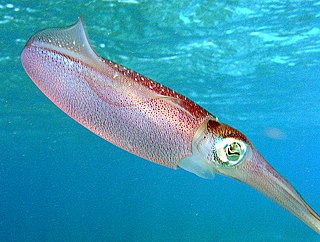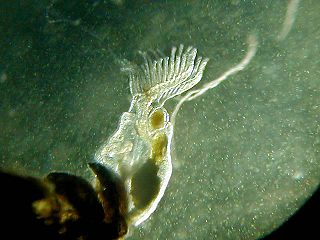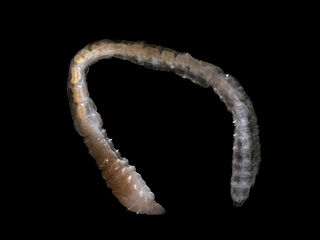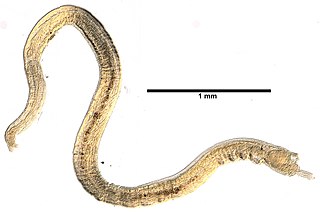
Polychaeta is a paraphyletic class of generally marine annelid worms, commonly called bristle worms or polychaetes. Each body segment has a pair of fleshy protrusions called parapodia that bear many bristles, called chaetae, which are made of chitin. More than 10,000 species are described in this class. Common representatives include the lugworm and the sandworm or clam worm Alitta.

Lophotrochozoa is a clade of protostome animals within the Spiralia. The taxon was established as a monophyletic group based on molecular evidence. The clade includes animals like annelids, molluscs, bryozoans, and brachiopods.

The lophophore is a characteristic feeding organ possessed by four major groups of animals: the Brachiopoda, Bryozoa, Hyolitha, and Phoronida, which collectively constitute the protostome group Lophophorata. All lophophores are found in aquatic organisms.

The "Platyzoa" are a group of protostome unsegmented animals proposed by Thomas Cavalier-Smith in 1998. Cavalier-Smith included in Platyzoa the phylum Platyhelminthes, and a new phylum, the Acanthognatha, into which he gathered several previously described phyla of microscopic animals. Later it has been described as paraphyletic, containing the Rouphozoa and the Gnathifera. Since 2022 it is believed that Platyozoa are monophyletic and also includes Mesozoa.

The Clitellata are a class of annelid worms, characterized by having a clitellum – the 'collar' that forms a reproductive cocoon during part of their life cycles. The clitellates comprise around 8,000 species. Unlike the class of Polychaeta, they do not have parapodia and their heads are less developed.

Eunicidae is a family of marine polychaetes. The family comprises marine annelids distributed in diverse benthic habitats across Oceania, Europe, South America, North America, Asia and Africa. The Eunicid anatomy typically consists of a pair of appendages near the mouth (mandibles) and complex sets of muscular structures on the head (maxillae) in an eversible pharynx. One of the most conspicuous of the eunicids is the giant, dark-purple, iridescent "Bobbit worm", a bristle worm found at low tide under boulders on southern Australian shores. Its robust, muscular body can be as long as 2 m. Eunicidae jaws are known from as far back as Ordovician sediments. Cultural tradition surrounds Palola worm reproductive cycles in the South Pacific Islands. Eunicidae are economically valuable as bait in both recreational and commercial fishing. Commercial bait-farming of Eunicidae can have adverse ecological impacts. Bait-farming can deplete worm and associated fauna population numbers, damage local intertidal environments and introduce alien species to local aquatic ecosystems.

The Chaetopteridae are a family of marine filter-feeding polychaete worms that live in vertical or U-shaped tubes in tunnels buried in the sedimentary or hard substrate of marine environments. The worms are highly adapted to the hard tube they secrete. Inside the tube the animal is segmented and regionally specialized, with highly modified appendages on different segments for cutting the tunnel, feeding, or creating suction for the flow of water through the tube home. The modified segments for feeding are on the 12th segment from the head for members of this family.

Errantia is a diverse group of marine polychaete worms in the phylum Annelida. Traditionally a subclass of the paraphyletic class Polychaeta, it is currently regarded as a monophyletic group within the larger Pleistoannelida, composed of Errantia and Sedentaria. These worms are found worldwide in marine environments and brackish water.

Arenicolidae is a family of marine polychaete worms. They are commonly known as lugworms and the little coils of sand they produce are commonly seen on the beach. Arenicolids are found worldwide, mostly living in burrows in sandy substrates. Most are detritivores but some graze on algae.

Scolecida is an infraclass of polychaete worms. Scolecids are mostly unselective deposit feeders on marine detritus.

Palpata is a subclass of polychaete worm. Members of this subclass are mostly deposit feeders on marine detritus or filter feeders. Palpata has become superfluous with the elevation of Canalipalpata to subclass.

The annelids, also known as the segmented worms, comprise a large phylum called Annelida. The phylum contains over 22,000 extant species, including ragworms, earthworms, and leeches. The species exist in and have adapted to various ecologies – some in marine environments as distinct as tidal zones and hydrothermal vents, others in fresh water, and yet others in moist terrestrial environments.

Flabelligeridae is a family of polychaete worms, known as bristle-cage worms, notable for their cephalic cage: long slender chaetae forming a fan-like arrangement surrounding the eversible head. Unlike many polychaetes, they also have large, pigmented, complex eyes.

Maldanidae is a family of more than 200 species of marine polychaetes commonly known as bamboo worms or maldanid worms. They belong to the order Capitellida, in the phylum Annelida. They are most closely related to family Arenicolidae, and together form the clade Maldanomorpha.
Rhodininae is a subfamily of marine polychaete worms in the family Maldanidae.

Sedentaria is a diverse clade of annelid worms. It is traditionally treated as a subclass of the paraphyletic class Polychaeta, but it is also a monophyletic group uniting several polychaetes and the monophyletic class Clitellata. It is the sister group of Errantia.
Lumbriclymeninae is a subfamily of marine polychaete worms in the family Maldanidae.
Notoproctus is a genus of marine polychaete worms in the family Maldanidae. It is the only member of the subfamily Notoproctinae.

Pleistoannelida is a group of annelid worms that comprises the vast majority of the diversity in phylum Annelida. Discovered through phylogenetic analyses, it is the largest clade of annelids, comprised by the last common ancestor of the highly diverse sister groups Errantia and Sedentaria and all the descendants of that ancestor. Most groups in the Clade find their ancestors within the Cambrian explosion when Annelid diversity expanded dramatically. The Pleistoannelida clade covers a variety of traits. However, the evolution of simple to complex eyes, developed papillae for burrowing, and for some specialized radioles for feeding can be seen universally across every species. New findings have discovered the range of Annelid diversity have led to uncertainty if groups with developed ancestral traits should remain within the clade. Furthermore, there's been a lack of recently discovered Annelid traits being used in the categorization of groups within the clade, leading to many hypothesis on how to do so and which should remain within the clade. Currently three smaller clades that were originally a part of the groups Errantia and Sedentaria have been proven to fall outside while still being connected to the basal groups.

Protodriliformia is a clade of small marine polychaetes, comprised by the groups of meiofaunal interstitial worms Protodrilida and Polygordiidae, formerly considered "archiannelids". It is the most basal clade of Errantia.
















